Welcome to the forefront of payment innovation! The days of grappling with cash or swiping credit cards are fading into history. The emergence of contactless payment technology has completely transformed the way transactions are conducted, presenting a smooth and secure approach to managing purchases. Whether you’re a technology enthusiast eager to delve into this pioneering advancement or simply intrigued by its advantages, our step-by-step manual is here to unveil the mysteries of contactless payments.
Introduction to Contactless Payment Technology
If you are already acquainted with the rudiments of using credit or debit cards, adapting to contactless payment technology will feel familiar. The primary distinction lies in the fact that instead of swiping or inserting your card into a reader, you merely need to place your card close to an NFC-enabled terminal and await the processing of the transaction.
In most instances, you’ll be prompted to enter your PIN for security purposes. However, some financial institutions are now affording the choice of utilizing biometric data, such as fingerprint or iris scans, for authentication.
In the event of uncertainty regarding the NFC compatibility of a specific terminal, keep an eye out for the contactless symbol, usually displayed alongside the standard credit card logo. Occasionally, a sticker indicating NFC compatibility might also be present.
To initiate the process, all that’s required is a credit or debit card configured for contactless payments. If you’re unsure about your card’s compatibility, it’s advisable to confirm with your bank or card issuer.
Step-by-Step Tutorial for Using Contactless Payment Technology
Assuming you possess a compatible smartphone and payment method, utilizing contactless payments is straightforward. For in-store payments, simply position your smartphone close to the checkout terminal and follow the provided instructions. Apple Pay users may need to authenticate using Face ID or Touch ID, while Google Pay functions in a similar manner for Android users.
To employ contactless payments, your smartphone must be equipped with NFC capabilities. Modern smartphones typically integrate this technology, though if yours doesn’t, you can acquire an NFC-enabled sticker or case. Once you possess an NFC-compatible device, adding your credit or debit card information is uncomplicated.
For Apple Pay users, navigate to the Wallet app and select “Add Credit or Debit Card.” You can then employ your device’s camera to capture your card’s details or input them manually. Additionally, identity verification via text message or a bank call may be necessary. Android users can launch the Google Pay app and opt for “Add a credit or debit card.” Here again, you can utilize your device’s camera for capturing card data or input it manually. Verification of identity through a text message or bank call might also be required.
Once a card is integrated into your digital wallet, its use is simple. At retail outlets, just hold your smartphone close to the checkout terminal and adhere to the prompts. Online shopping follows a comparably straightforward process – during checkout, select “Use Phone.”
Benefits of Leveraging Contactless Payment Technology
Contactless payment technology boasts numerous advantages. It provides a swift and convenient approach to settling payments for goods and services. The need to grapple with cash or cards is eliminated; instead, a simple tap of your card on the reader facilitates your transaction.
Furthermore, contactless payment technology enhances security compared to conventional payment methods. The card remains in your possession throughout the process, mitigating the risk of loss or theft. Should your card ever go missing, swift cancellation can prevent unauthorized charges.
Embracing contactless payment technology contributes to diminishing paper waste. Traditional payment methods necessitate generating a receipt for each transaction. With contactless payments, receipt issuance is optional, enabling paper conservation and environmentally conscious behavior.
Safety and Security in the Realm of Contactless Payment Technology
In recent years, contactless payment technology has gained remarkable popularity as a secure mode of transaction. This innovation enables payments without physical contact with the payment terminal. Simply placing your credit or debit card near the terminal initiates a wireless transaction.
The chief advantage of contactless payment technology is its swiftness and convenience. The need to handle cash or cards is eradicated, thereby expediting checkout procedures. Additionally, it aids in streamlining queues during busy periods.
Security constitutes another noteworthy attribute of this technology. During credit or debit card payments, the transmission of your data is encrypted and wirelessly transmitted to the merchant’s bank. This methodology thwarts interception of data and significantly reduces the likelihood of compromise compared to conventional payment methods such as cash or checks.
Contemplating the adoption of contactless payment technology entails several considerations. Firstly, ascertain whether a merchant accepts this form of payment before attempting a transaction. Additionally, most contactless payments impose a cap, often around £30, necessitating alternative payment modes for larger transactions. To effect a contactless payment, the presence of your credit or debit card is mandatory – hence, ensuring its availability is pivotal.
Diverse Varieties of Contactless Payment Alternatives
Several variations of contactless payment alternatives are available. The foremost is NFC (Near Field Communication), employing radio waves to communicate with nearby devices. NFC-enabled devices facilitate payments by merely positioning them close to a contactless reader.
An additional category of contactless payment is RFID (Radio Frequency Identification), which relies on electromagnetic fields to interact with devices situated at greater distances. RFID-enabled devices facilitate payments by waving them near a contactless reader.
Another option is Bluetooth Low Energy (BLE), utilizing radio waves to communicate with proximate devices while consuming less energy than NFC. BLE-enabled devices enable payments by holding them near a contactless reader.
Configuring Your Contactless Payment Account
Given the possession of an NFC-enabled smartphone or equivalent device, configuring a contactless payment account is a simple endeavor. Download the relevant app compatible with your smartphone (Apple Pay, Google Pay, Samsung Pay, etc.) and follow the prompts to establish an account. Typically, linking your contactless payment account with a credit or debit card is necessary for utilization. Once setup is complete, tap-and-go payments can be executed at any merchant embracing contactless payments.
During the maiden use of a contactless payment system, you may be required to input your PIN or endorse a receipt. This serves security purposes, ensuring only authorized individuals execute transactions with your account. Subsequent transactions usually demand no additional actions beyond holding your device in proximity to the contactless payment terminal, awaiting transaction processing. The process is effortlessly seamless!
Frequently Raised Queries Regarding Contactless Payments
FAQs About Utilizing Contactless Payments
What exactly is contactless payment?
Contactless payment entails an electronic payment method that circumvents physical card contact or swiping. Transactions are executed by placing your card in proximity to a contactless reader.
How do I engage in contactless payments?
Commencing contactless payments mandates possession of a compatible card or device. For cards, confirmation of a contactless symbol is imperative. If such a symbol exists, immediate usage for contactless payments is feasible. Alternatively, smartphones and mobile devices can substitute for cards. Download a compatible app (Apple Pay, Google Pay, etc.), insert credit or debit card information, and subsequently execute transactions by placing your smartphone near the contactless reader.
Where can I perform contactless payments?
Contactless payments are accepted across myriad stores worldwide. The presence of the contactless symbol at checkout confirms acceptance. Public transportation systems in numerous cities also accommodate contactless payments (e.g., London, New York).
Special terminals at train stations and buses permit payment by tapping your card or smartphone.
Conclusion
The landscape of contactless payment technology is burgeoning and gaining prevalence, necessitating a comprehensive grasp of its mechanics. This guide has elucidated both the overarching process and the sequential actions required to execute successful transactions using this technology. Equipped with its combination of convenience and security features, the exploration of contactless payments is indeed a venture worth undertaking for a smoother method of procuring goods and services.



































